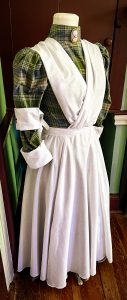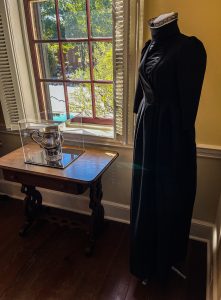The Gorgas House Museum has two dresses on display inside the home teasing a larger exhibit, Threaded Through History, currently at the at the Mildred Westervelt Warner Transportation Museum. The dresses showcase student work, highlight University and community organization partnerships, and match the Gorgas House Museum’s period of interpretation and use.
University of Alabama student Marie Bonds recreated the black mourning dress. It contains a fake blouse insert and dresses of this type were worn during a period of mourning for a deceased loved one. Different stages of mourning required different types of black garments. During a time of deep mourning, women wore black dresses, trimmed with black crêpe or fragment with a crimped appearance, and long black crêpe veils. In a second mourning period, crêpe fabric was removed, and only black clothes were worn. A final period of mourning, called half-mourning, included black clothes, but also shades of white, blue, and grey.

UA Student Joseph Musgrove designed the nurse’s uniform. Joseph said this about the dress, “I modeled the nurse after the Red Cross nurses in research photos from the 1890s. The women who were acting as nurses during war efforts (Spanish-American War) were largely volunteer or untrained, and they would wear a simple day dress underneath a ‘uniform’ of [a] full apron, and an armband bearing the Red Cross or a traditional nurse’s cap. I named my dress Lily to represent good health, peace, and the delicate state of mourning.”
To see more dresses like this, visit the Mildred Westervelt Warner Transportation Museum‘s exhibit, Threaded Through History! The exhibit is designed as a historic fictional narrative related to the early 20th century outfits selected to be recreated. The inspiration for the exhibit stemmed from historic Harper’s Bazar Magazine fashion plates and the desire to concentrate on this period of Tuscaloosa history that is generally glossed over in favor of other historic time periods. It is a pivotal time in an underrepresented period of technological advancement and modernization in which Tuscaloosa saw an immense amount of growth and change post-Civil War while still maintaining a sense of simplicity and tradition.
This exhibit is a collaborative project with the Missouri Historical Society, The University of Alabama Department of Theatre and Dance, and the Mildred Westervelt Warner Transportation Museum with significant artistic contributions by Ms. Zoey Simpson. Ms. Simpson is a UA alumna with a bachelor’s degree in Apparel Design/Textiles and Studio Art and has a master’s degree in Fashion Design from Kingston School of Art, London, UK.
